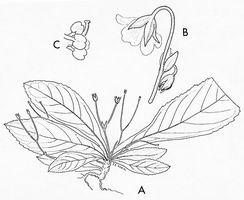
Ann. Missouri Bot. Gard. 25 (1979)
Full name and orig. publication: Napeanthus Gardn., London J. Bot. 2: 13 (1843).
Etymology: From the Greek ναπος, εος, napos, eos = grove, open woodland, and ανθος, anthos = flower; “Flower of the wooded vale.”
Synonyms: Marssonia Karst. (1860), Hatschbachia L.B.Smith (1953).
Infrafamilial position: Gesnerioid Gesneriaceae (Gesnerioideae) - Napeantheae.
Description: Terrestrial, perennial herbs with rhizomes. Stem short, decumbent, rooting at the nodes, or ± absent. Leaves opposite, (sub)isophyllous, petiole short or lacking, sessile leaves joined by a line across the stem; lamina membranous to papyraceous and dry, linear-lanceolate to oblong-spathulate, usually somewhat falcate. Nearly entire or crenate-serrate toward the apex, somewhat sinuate, stomata usually in groups. Axillary cymes 1- to many-flowered, pedunculate, subumbellate to racemose-paniculate; peduncle and pedicels slender. Flowers actinomorphic to zygomorphic. Sepals connate at the base (to ˝ their lenght) to form a campanulate calyx. Corolla white to blue, pink or lilac; rotate or campanulate, sometimes ventricose, falling soon; tube 1-2 times as long as the calyx, limb spreading, lobes usually entire, emarginate at the apex. Stamens 5, equal, or 4 and a staminode, often didynamous, included or exserted; filaments free; adnate to the base of the corolla tube; anthers free, orbicular or oblong, apically confluent, dehiscing by longitudinal slits. Nectary lacking. Ovary superior, ovoid to globose; style curved, persistent; stigma slightly bilobed. Fruit a capsule included in the persistent calyx, oblong, ovoid or globose, 2- or 4-valved, the valves not persistent after dehiscence.
Chromosome number: Unknown.
Species number: 23, many more to be expected.
Species names (incl. publication and synonyms): See Skog, L.E. & J.K. Boggan. 2005: World checklist of Gesneriaceae: http://persoon.si.edu/Gesneriaceae/Checklist.
Type species: Napeanthus primulifolius (Raddi) Sandw.
Distribution: Throughout the neotropics.
Ecology: Low forest herb, growing in shady, damp places and on mossy rocks.
Notes: Diagnostic characters of the genus are: (1) comparatively small habit (mostly rosette plants), (2) absence of scaly rhizomes, (3) stomatal clusters on leaf underside, (4) inflorescences with bracteoles, (5) rotate (rarely tubular and bilabiate) corolla, (6) white or pale blue/pink corolla colour, (7) 4 or 5 stamens grouped around the style and stigma, (8) absence of a nectary. The flowers exhibit clearly the syndrome of oligandric pollen-flowers, actual pollination has not been observed yet.
Selected references: Leeuwenb., Acta Bot. Neerl. 7: 340-354 (1958), rev; Skog, Ann. Missouri Bot. Gard. 65: 951-954 (1979), reg. rev. (Panama); Skog, Monogr. Syst. Bot. Missouri Bot. Gard. 85: 1114-1128 (2001), reg. rev. (Nicaragua).
Bibliography: See Skog, L.E. & J.K. Boggan. 2005. Bibliography of the Gesneriaceae. 2nd edition: http://persoon.si.edu/Gesneriaceae/Bibliography.
Illustrations:
 |
Napeanthus apodemus J.D.Sm.
Ann. Missouri Bot. Gard. 25 (1979) |
last modified: 2007-01-05